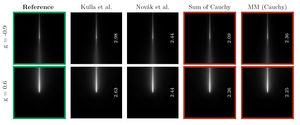Information
- Publication Type: Master Thesis
- Workgroup(s)/Project(s):
- Date: 2023
- Date (Start): November 2018
- Date (End): 17. April 2023
- TU Wien Library:
- Diploma Examination: 17. April 2023
- Open Access: yes
- First Supervisor: Michael Wimmer
- Pages: 109
- Keywords: global illumination, virtual point lights, virtual ray lights, ray tracing
Abstract
This thesis provides new importance sampling techniques for Virtual Ray Lights forRendering Scenes in Participating Media. We will discuss the foundations of rendering scenes with participating media first, to get an understanding of this topic. Furthermore, we will provide an overview of different approaches that can be used for the rendering of these scenes. Virtual Ray Lights is an algorithm that traces light rays from the light source through the scene, which are then evaluated individually for each camera ray. Importance sampling is used on both rays to get a samples for each ray for which their contribution can be calculated. As a solid understanding of the original algorithm is needed to understand the newapproaches that we introduce, a focus is laid on explaining the mathematical foundations of the approach. We highlight the shortcomings that we found for rendering anisotropic participating media and introduce our solutions to solve them more efficiently. We provide two different solutions to the problem that we evaluated in the originalalgorithm. Our solutions are explained mathematically, via pseudo code and are evaluated with a multitude of tests. The goal of this thesis is to provide new, simple, robust and fast solutions to rendering scenes with anisotropic participating media.Additional Files and Images
Weblinks
BibTeX
@mastersthesis{oppitz-2023-ais,
title = "Advanced Importance Sampling Techniques for Virtual Ray
Lights",
author = "Michael Oppitz",
year = "2023",
abstract = "This thesis provides new importance sampling techniques for
Virtual Ray Lights forRendering Scenes in Participating
Media. We will discuss the foundations of rendering scenes
with participating media first, to get an understanding of
this topic. Furthermore, we will provide an overview of
different approaches that can be used for the rendering of
these scenes. Virtual Ray Lights is an algorithm that traces
light rays from the light source through the scene, which
are then evaluated individually for each camera ray.
Importance sampling is used on both rays to get a samples
for each ray for which their contribution can be calculated.
As a solid understanding of the original algorithm is needed
to understand the newapproaches that we introduce, a focus
is laid on explaining the mathematical foundations of the
approach. We highlight the shortcomings that we found for
rendering anisotropic participating media and introduce our
solutions to solve them more efficiently. We provide two
different solutions to the problem that we evaluated in the
originalalgorithm. Our solutions are explained
mathematically, via pseudo code and are evaluated with a
multitude of tests. The goal of this thesis is to provide
new, simple, robust and fast solutions to rendering scenes
with anisotropic participating media.",
pages = "109",
address = "Favoritenstrasse 9-11/E193-02, A-1040 Vienna, Austria",
school = "Research Unit of Computer Graphics, Institute of Visual
Computing and Human-Centered Technology, Faculty of
Informatics, TU Wien",
keywords = "global illumination, virtual point lights, virtual ray
lights, ray tracing",
URL = "https://www.cg.tuwien.ac.at/research/publications/2023/oppitz-2023-ais/",
}

 poster
poster thesis
thesis


